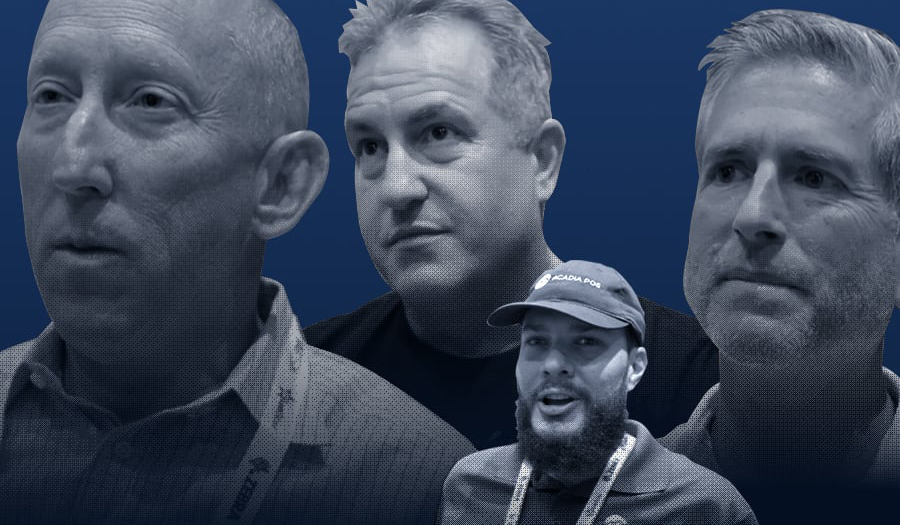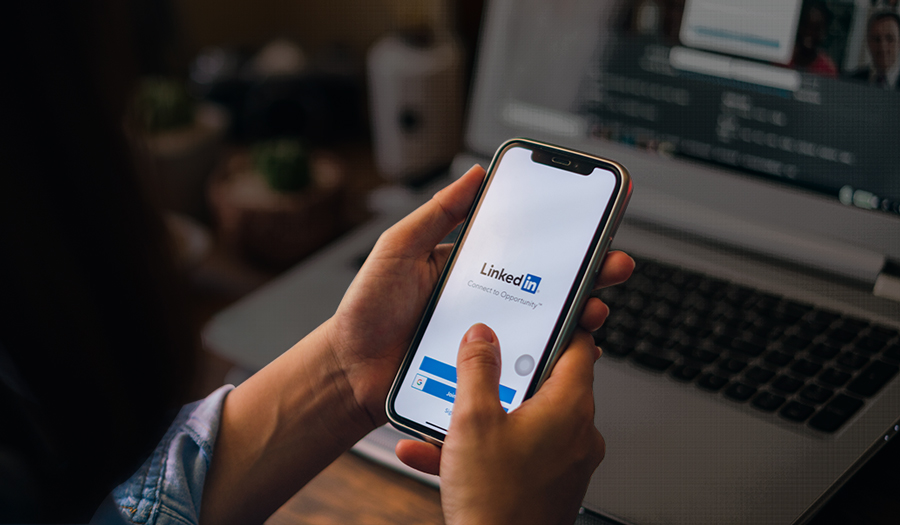
Only 1% of LinkedIn users actively share content each month. That small group netted over 9 billion (!) impressions of their posts in 2019.1
30 million users log in every day2, and the network boasts over 830 million users globally.
An enormous opportunity exists to gain attention for yourself and your company by joining that 1% and sharing regularly to your LinkedIn feed—both personally, and via company profiles.
There's a catch, though. Two catches, actually.
The hard truth
Unless you've reached cult of brand status, no one is logging in to find out about the new product or service your company rolled out. I know this hurts to hear, but go look around for yourself, the companies and individuals who are only posting and re-sharing their company messages aren't getting much engagement, especially from the people who matter (customers and prospects).
The second catch is that building an audience of people who could buy from you, and creating the content that they want isn't easy nor fast.
You may be thinking to yourself: this sounds a lot like I'm being asked to market; not to sell. You're right. Modern social selling looks a hell of a lot like marketing.
The harder truth
Most people reading this article will find reasons not to execute a LinkedIn strategy like the one we'll describe here. Likely, the reasons will be related to time or resources, but what that really means is that they won't make LinkedIn a priority and they don't believe that LinkedIn is a critical place for businesses and business people to establish a presence in 2022. That's OK.
In fact, it's precisely why those who act on this advice have a better chance of winning.
Before we get into the meat of the advice, let's first take a look at some of the common mistakes of people who are trying on LinkedIn, but have a flawed approach.
What not to do
DON'T IMMEDIATELY INVADE THE DIRECT MESSAGES
You've seen it. I've seen it. We've all seen it. You receive a connection request with some kind of vague reasoning for the request ("I want to stay in touch with people in XYZ position / industry") and then within 1 to 24 hours, you have a product pitch in your LinkedIn inbox from a company you've never heard of that just needs 30 minutes of your time to pressure sell you.
I've had people go a step further, appearing to start a "genuine" DM conversation, but their desire to pitch is so strong that they don't allow the conversation to get more than 2 or 3 back-and-forths deep before they get to the pitch. Don't do this. It doesn't work.
DON'T POST EXCLUSIVELY ABOUT THINGS RELATED TO YOUR COMPANY
This may sound counterintuitive—after all, how are you supposed to get business value from LinkedIn if you're not allowed to talk about your company?
I'm not suggesting that you never mention your company, instead, I'm suggesting that if your posts were a pie chart, the big slices would be posts that teach your audience something and make them better people and/or professionals.
Your primary objective is to become a person (or a company) who people engage with because you post things that enrich their professional lives. If you achieve this, where you work, what you do, and the problems you solve for companies will not be a mystery, and people will know your name and where to find you, in fact, others may even point them in your direction.
DON'T EXPECT AN IMMEDIATE OR DIRECTLY MEASURABLE RESULT—AND DON'T QUIT
The strategy we'll outline here is purely organic, which means it doesn't rely on paid advertising. Like most things that work in 2022, it is not fast and easy to scale and it's perhaps impossible to automate. It takes dedication and a belief that over time, you'll reap the rewards of your work.
Success will be measured qualitatively and, in the beginning, big numbers aren't the name of the game.
You'll be building a network of prospects slowly and steadily, and what you're looking for is engagement from the right people. You're looking for small indicators, such as comments, questions, likes, and shares of your content—not from your colleagues—but from your (potential) prospects. Even if the people who engage with you could never buy from you for some reason—if they look the same as people who could, you're on the right track.
Maybe this sounds like obvious advice, or maybe it doesn't—but if you observe the number of companies who are only sharing their newest product release and whose engagement outside of their own team is minimal? You'll note that successfully implementing this strategy is very rare.
Designing a content strategy
The advice here is sophisticated in its simplicity. A content strategy is about finding the intersection of your expertise or access to information and what your audience truly cares about.

This is the hardest part. The good news is, I'm not asking you to etch your strategy into stone. If, after building a relevant audience and posting regularly for a couple of quarters you aren't seeing glimpses of positive qualitative feedback? You can adjust your content strategy on the fly until you find a sweet spot.
The nuts and bolts
A content strategy may have a number of content pillars or themes contained within it. It should also have a variety of content types that will result from executing on these pillars.
What you create doesn't need to be complex or take weeks to produce—but often, a combination of long-form (podcasts, reports, or articles like this one) and short-form or "snackable" content (such as infographics, short video clips, memes, stylized quotes, audio clips, and text posts) is a recipe for success.
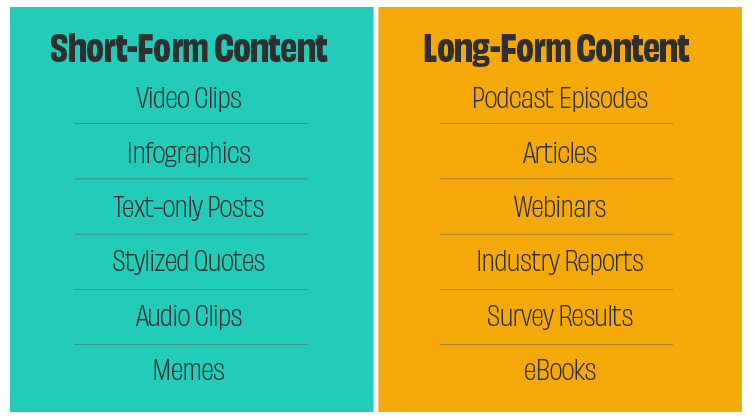
People consume content differently based on their personality, their job role, their age, and several other factors, so giving them a variety of content types is a good idea. You may find over time that as a whole, your audience seems to favor 1 or 2 of your content lengths or formats—don't be scared to double down on what is working.
IMPORTANT:
When it comes to creating content, it's helpful to be a subject matter expert or a thoughtful person with a unique point of view—but it is not a requirement. You can and should leverage data and the expertise of others as a key component of your content creation strategy.
The easiest example of leaning on the expertise of others for content creation is podcast hosting.
In this scenario, you are simply the vehicle by which expertise is extracted from your featured guests. Keep in mind that a podcast strategy doesn't need to be about gaining 10,000 subscribers and getting them all to watch every episode in its entirety—it can instead be about creating minute-long clips that key on important concepts that you share to LinkedIn (snackable content).
Perhaps the most underrated aspect of hosting a podcast is learning from your guests.
A strong framework for coming up with a podcast concept is this: if I were my ideal prospect, what is the name of the podcast that I would be honored to be featured on? Create that podcast, invite executives and thought leaders from companies that COULD be your customers, and interview them. THAT is content that your OTHER prospects would find valuable, right? Learning from peers, or better yet, those that are in the places we want to be in our careers is very strong content. If it's not clear, I am suggesting very strongly that you start interviewing and recording conversations with people who look (firmographically) like your customers and turn those conversations into the content.
Another example is to collect or curate insights from a variety of places and pull them into a single post, for example: "Here are 7 moments in time where decisive executive action saved a software business," or "We asked 12 chief marketing officers how they measure the ROI from trade shows."
Think about other ways you can glean insights from others and bring those tips and tricks to your audience.
How to land on your content pillars / themes:
- Speak to your existing customers to learn how you can be helpful BEYOND what your business does or can do for them. Identify common themes and create content that helps people better address business challenges or develop themselves professionally. As suggested above, you could record these conversations and turn the best clips into shareable content—these conversations will undoubtedly uncover even more nuanced topics you can dig into and create content around.
- Think about unique access you may have to data that others either don't have or aren't willing to share for the benefit of others—would synthesizing and sharing this data be helpful and build trust with current and potential customers?
- Utilize tools like Spark Toro or Buzz Sumo to learn more about your audience. Which social accounts and hashtags do they follow? Which podcasts do they listen to? Which websites are they visiting and what content is performing well in your niche today? Which topics are being discussed in those places that are sparking meaningful conversations?

Questions to ask when validating a content pillar:
- If I were my ideal buyer, would I find this content professionally helpful for myself or my business?
- Is this a repeatable theme that I can scale by changing a variable (such as the featured guest or topic) and produce regularly?
- Which content formats (images, video clips, graphics, memes) will this pillar result in? Do I think these formats will play well on LinkedIn?
- Is there a content creator in a different industry doing something similar and seeing success with it?
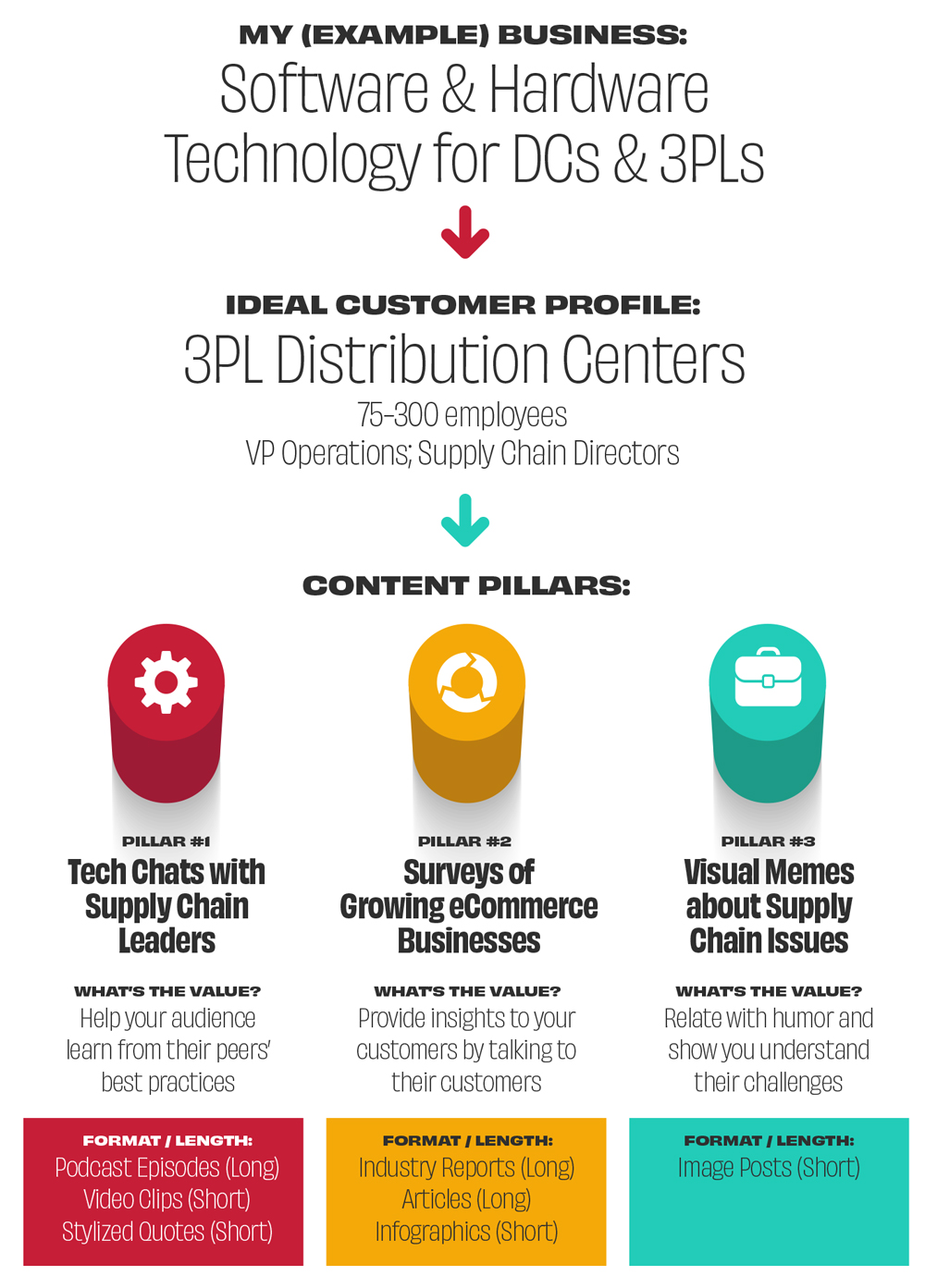
Be deliberate about building an audience
This is the most tactical and easy to achieve advice in this article. If you follow these steps, you will build a group of connections who look like your ideal customers. Whether you turn those connections into an audience will be determined by the quality of your execution and your consistency.
Step 1
Create a list of companies that could be your customers based on their industry, geography, size, or whatever criteria make sense for your business. This will likely be a manual process unless you have access to a tool like ZoomInfo or Dun & Bradstreet. There isn't a right size for this list.
Step 2
Every day, set aside some amount of time to search for these companies on LinkedIn. Go to their Company Page, and then go to their People tab.
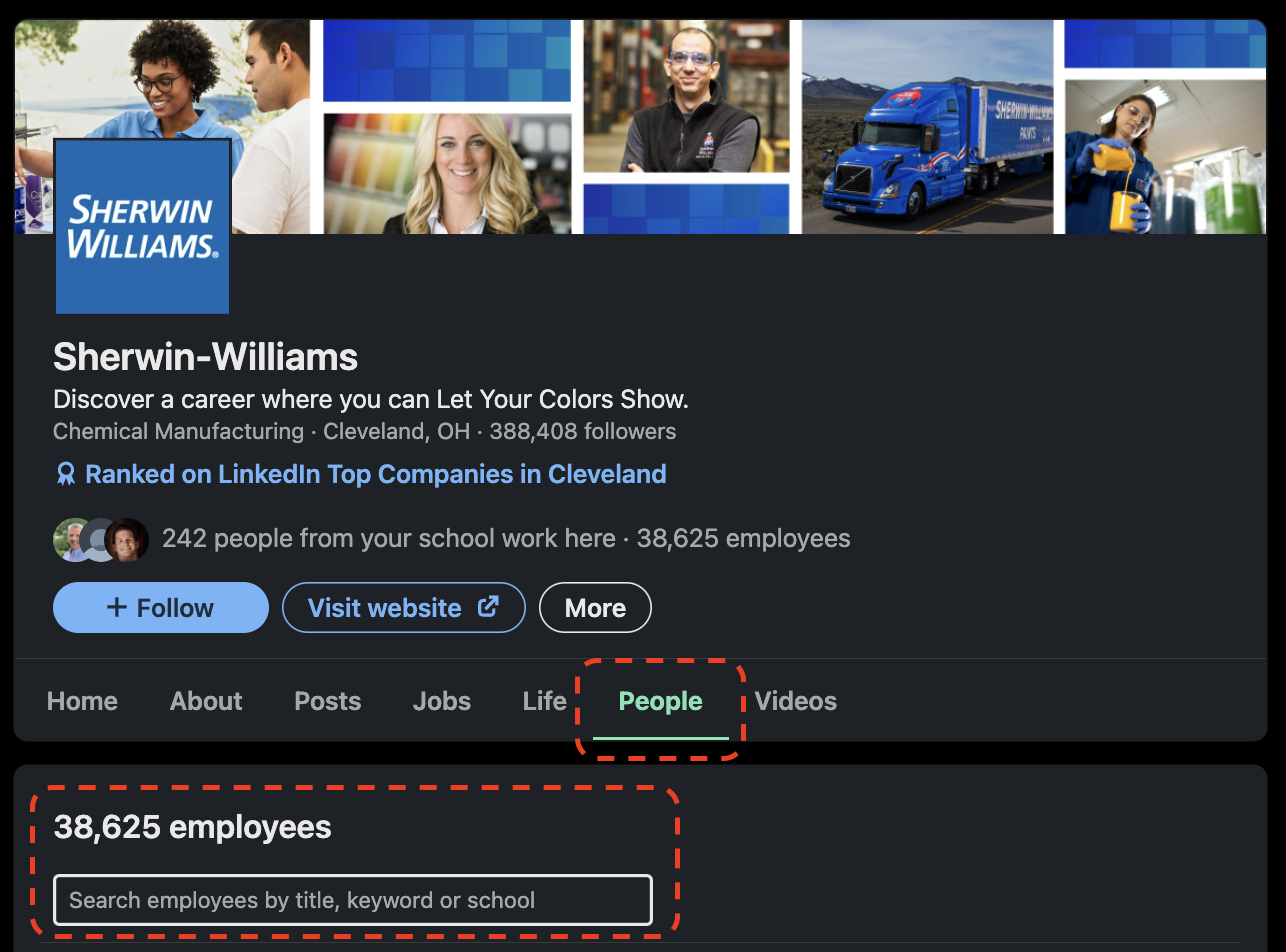
When choosing who to connect with, it's worth analyzing how active they are on the network. After all, if someone isn't somewhat active on LinkedIn, they aren't going to have much value as part of your audience.
To get an idea about this, click on a person's name to visit their profile, and scroll down to the Activity section. Here, you see if they are posting to their account (which as we've mentioned, only 1% of users are doing regularly). The better place for a true idea of how active an individual is on LinkedIn is in the Show All Activity area (see below) where you can see comments, shares, and other "non-sharing" activities. Where possible, add people to your network who are regularly contributing to conversations.
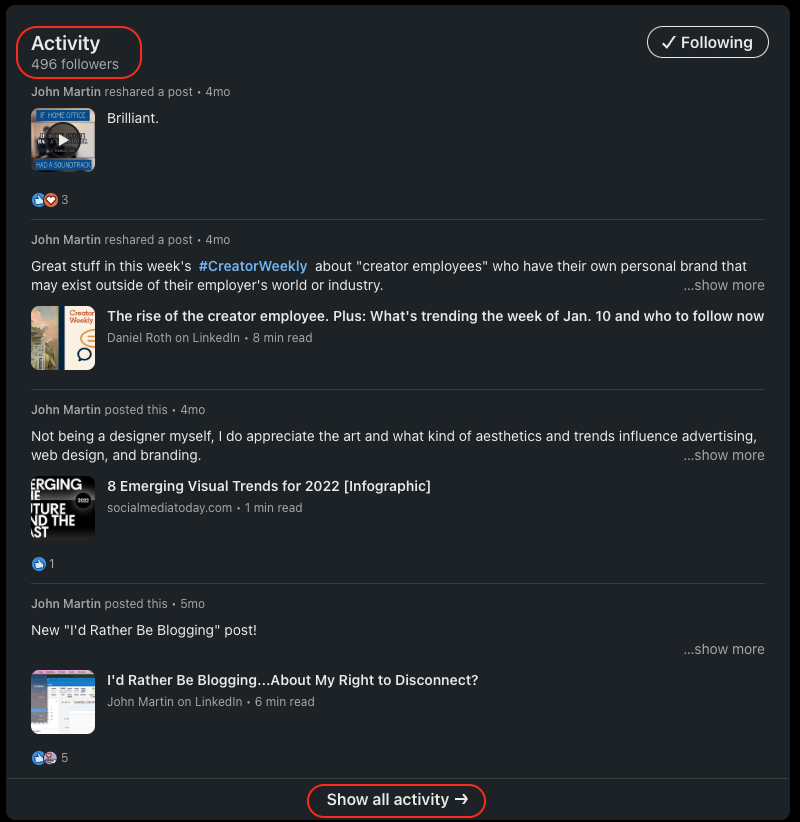
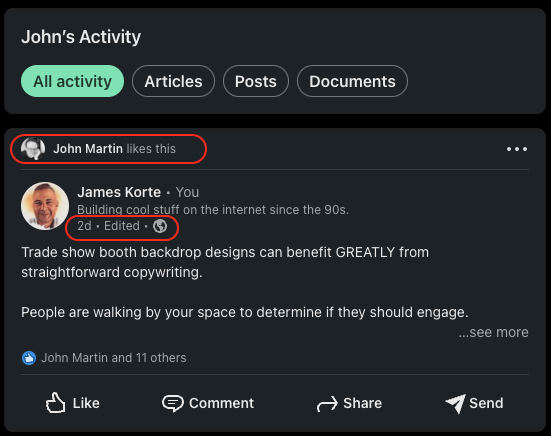
Step 3
Search using keywords to find the people who fit your customer profile most closely. Example: operations, vice president, information technology (or whatever is relevant to your product or service).
Add a handful of people from each company—again, there is no right number here, but I would suggest sending requests to at least five people per company. This is how, over time, you'll build an audience of relevant people that you'll create content for.
Pro Tip:
If you want to optimize the acceptance rate of your connection requests, add a note along with your request. Assure these potential new connections that you're not planning to send them a sales pitch, and let them know what they can expect from your feed if they accept your request.
IMPORTANT: If you take this tip, the "what should they expect" should be an extremely concise overview of your content themes—not the business problems that your company solves—you'll share that with them slowly, over time.
This deliberate audience building should never end—but eventually, the engagement you'll get from the connections you make manually will result in a network effect. Engagement from the people you've manually added will increase the reach and visibility of the content you share to similar people.
Any time someone new engages with your content in the form of likes, comments, or shares—add these new people to your network directly. This model of audience building requires a significant and regular investment of time, but it will result in an audience that you can access repeatedly, compared with paid advertising, which provides immediate scale, but zero sustainability in that you can only access this audience when you're willing to pay for it.
What to do to accelerate success
LASER FOCUS ON WHAT MATTERS TO YOUR AUDIENCE
This point has already been made but it's worth emphasizing—your feed should be focused on providing resources—including a heavy dose of original content—that your ideal customers can learn and grow from. Save the self-serving shares that talk about you or your business for high-quality content like case studies, customer testimonials, events, and special promotions. People should view you or your company as an entity that is on LinkedIn to help first, and as a product or service provide second.
PUBLISH REGULARLY & BE PATIENT
Publishing regularly means creating regularly, and that's hard. This has been the biggest challenge for me personally. However, consistency is key to becoming known to your audience and building a rapport.
Keep in mind the idea of long-form vs. short-form or snackable content. Landing on a short-form theme that has high value to your audience, but that can be produced relatively quickly will really help you to publish frequently. Don't let the idea of publishing every day, or even once a week be a blocker to getting started. Once you feel solid about your content strategy, start to share in a format (such as plain text posts with strong formatting) that takes very little production.
Do this in parallel with the one-by-one audience-building strategy so that your new connections start to see your content quickly. Over time you can polish and refine your content creation execution, bringing higher-level production quality and a variety of post formats to the table.
BE OBSERVANT OF TRENDS
Observing creators who have built highly engaged audiences and make notes of their behaviors. How often do they engage? What is their tone? What post formats are they using? What time of day do they post? How do they format their copy? Develop an eye for details, they can make a big difference.
TELL THE FULL STORY IN THE FEED—DON'T ASK FOR A CLICK
LinkedIn profits when users stay on their network and consume advertising. As a result, when a new post includes an external link inside of the post itself, it will negatively affect that post's reach. A commonly used hack by creators is to avoid posting an external link in the post (if one is needed at all) and they will indicate that they've included the external link in the comments section.
FOLLOW & ENGAGE WITH INFLUENTIAL INDUSTRY PERSONALITIES
Think about large industry influencers (they exist in virtually every niche!) as an audience-building mechanism.
Individuals looking to grow their audience in a niche regularly leave thoughtful comments on the posts of bigger accounts, which can result in lots of reactions to their response—when you get people to react to your response—send them a connection request (but don't invade their DMs!)
Said more simply: use commenting as a way to gain attention to the content created by well-established personalities and brands as a way to build your audience and connections. Don't be scared to have a dissenting opinion from the original content creator, but be respectful and avoid negativity.
INCLUDE A FEW HASHTAGS
Hashtags have a functional purpose. People who regularly consume content on social networks use hashtags to find the conversations that are relevant to them as hashtags are used to group posts that relate to a certain topic. Hashtags aren't a magic bullet, but they can help increase your reach in a particular niche.
If you choose to activate Creator Mode on LinkedIn, you have the option of adding the hashtags that you most regularly share around.
OPTIMIZE YOUR PROFILE
If you're executing this strategy from a personal account, turn on creator mode. Update your headline (see example below) as this line of copy follows you around the network and helps add context to who you are as a professional when you leave comments on other people's content. Keep your picture up-to-date with a clear photo of you in decent lighting. Don't be scared to show some personality and uniqueness in your profile photo.

In closing
You have to be outstanding to stand out. None of this works for you or your business if you're sharing once a month and not bringing anything original to the table. This is a playbook that can work for brands and individuals, and if you're a CEO or Head of Marketing—perhaps you really don't have the time or the interest to execute this strategy.
But maybe there is someone in your sales or marketing department who already acts as a mouthpiece for your organization whether it be in meetings, at conferences, or appearing on podcasts run by other organizations—share this guide with them, give them the time and resources they need to experiment and see what comes of it.
Sources:
1 https://kinsta.com/blog/linkedin-statistics/
2 https://news.linkedin.com/about-us#Statistics
Looking for more tactical advice about LinkedIn?
Watch or Listen to the Podcast





